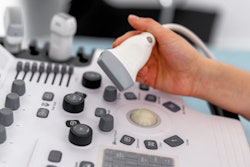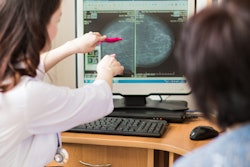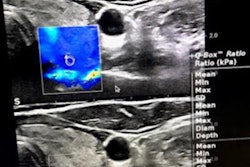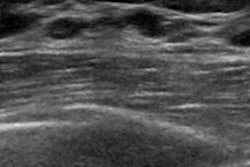
A new breast shear-wave elastography software algorithm can help to avoid false-negative breast cancer cases, according to findings presented March 28 at UltraCon in Orlando, FL.
In his talk, Dr. Richard Barr from Northeastern Ohio Medical University in Rootstown found that the commercial algorithm improves sensitivity of the elastography technique while sacrificing a small amount of specificity, eliminating the "soft" cancer artifact seen in false-negative cases.
"This [algorithm] has really perfected shear-wave elastography for us," Barr told AuntMinnie.com. "I think this application for breasts really demonstrates the power of looking at raw data and tailoring the algorithm to the condition or organ to get really good results."
Shear-wave elastography has been shown to help detect malignancies by measuring tissue stiffness, with cancerous tumors typically being stiffer. However, Barr said its ability to characterize breast lesions has been limited due to finding artifacts.
"The reality is these cancers aren't 'soft.' They're very hard, and the shear waves don't go through them because it's like a soundproof wall," Barr said.
Barr and colleagues wanted to test a new algorithm on breast 2D shear-wave elastography and compare the results to the existing algorithm.
The researchers saved raw shear-wave data on patients having an examination between 2019 and 2022 on a Sequoia research ultrasound unit (Siemens Healthineers). They included 298 patients with an average age of 56.3 years who had 394 lesions. Out of the lesions, 201 were found to be benign on follow-up longer than two years while 193 were biopsied (65 benign, 128 malignant).
The study authors processed the raw data from these lesions using the standard and new algorithms (both from Siemens). They placed 5-mm regions of interest in the highest stiffness in the lesion or adjacent 3 mm on the standard algorithm.
The researchers found higher average tissue stiffness values, as well as higher area under the receiving operating characteristic (AUROC) values, for the new algorithm over the standard algorithm.
| Performance of new shear-wave elastography algorithm vs. standard algorithm | ||
| Standard algorithm | New algorithm | |
| Average stiffness (benign lesions) | 2.37 m/s | 3.51 m/s |
| Average stiffness (malignant lesions) | 4.73 m/s | 8.45 m/s |
| AUROC | 0.90 | 0.96 |
The team also found that sensitivity increased from 45% to 99% for the new algorithm when using a threshold value of 5 m/s. Specificity, meanwhile, decreased from 95% to 82%. Additionally, the new algorithm's positive predictive value was 77% and the negative predictive value was 99%.
Barr said that these results are similar to what the team sees when it comes to strain elastography, something that has confounded the researchers.
"It just kind of gives us the confidence that the technique is working," he said. "In the past, we may have had discordant results between strain and shear wave. And I think that made a lot of people concerned about which one is right."
Barr told AuntMinnie.com that the team is planning an international, multicenter trial to confirm the results and cutoff values.
"We hope to get that started in the next several months and hopefully have that study done within a year," he said.



















